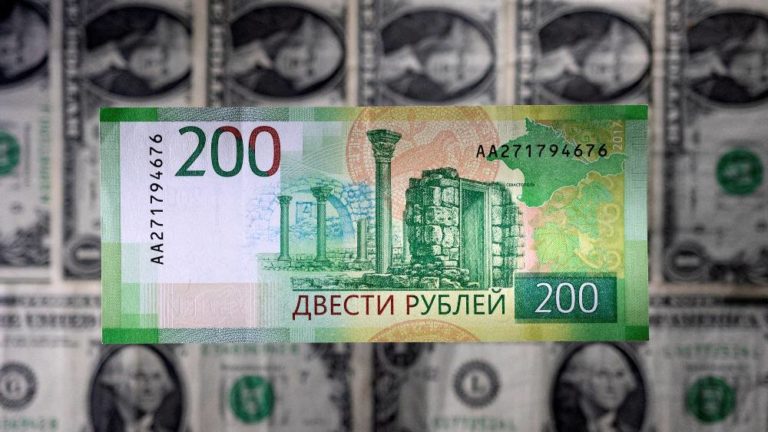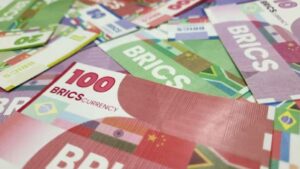The data shows that Russia is making rapid progress in its effort to diversify away from American assets. So Vladimir Putin knows what he is doing and he is not doing since last two months. Within the span of a decade, the country quadrupled its bullion reserves. And the pace is keeping up so far this year. Just imagine if more countries adopt a similar philosophy what it could mean for the dollar’s desirability compared with other assets, such as gold? The process is on, in fact. Putin’s quest to break Russia’s reliance on the U.S. dollar has set off a literal gold rush. Five months back, Poland and Hungary surprised everyone by making the first substantial gold purchases by a European Union nation. Even French President Emmanuel Macron has acknowledged that dependency on the U.S. currency is an issue of sovereignty.
The de-dollarization is here to stay
Russian’s central bank recently announced that it will pay a fixed price of 5,000 roubles ($52) per gram of gold between March 28 and June 30, 2022. This is below the current market value of around $68. Further, Russia’s central bank added that the resumption in buying will ensure supply and uninterrupted production of local gold. With this, Russia just wiped out about thirty percent of the value of the US dollar. With this development, it’s easier, safer, and more practical just to buy gold and let the Russia’s central bank decide what it wants to do with its own paper. The impact of what Russia has just done is a literal dagger to the heart of the US dollar and to the euro. No one will want those currencies anymore, and since the US barely manufactures anything domestically, when foreign countries cease accepting the dollar for payment, shortages of everything will slam the U.S. and Europe.
In other words, what Russia just did is the financial equivalent of detonating a nuclear bomb. In other words, there are 32 grams in each troy ounce. Further, 32 grams x 5,000 roubles per gram is 160,000 roubles. The conversion rate of roubles to US dollars is 100 Roubles, 90 Kopecs, to each US Dollar. Anyone wishing to buy oil or gas will need to either pay in roubles or pay in gold. And they won’t get the US Dollar value for the gold they tender as payment! With this development, globally everyone will be literally THROWING their money at the rouble and dumping dollars and euros to do it. Russia has an estimated $132 billion in gold stockpiles, roughly 20% of the holdings in the Russian Central Bank, thanks to heightened buying activity since the 2014 annexation of Crimea.
Those reserves are coupled with Russia’s $630 billion in foreign exchange reserves. Meanwhile, Russia has announced that it will only sell energy for roubles to unfriendly countries. So demand for the rouble will pick up, which could eventually turn the 5000RUB discount internationally into a premium, encouraging more gold flows into Russia internationally as well, and further draining the West of its gold reserves in favor or Russia.
The mainstream financial press is focused on the ‘Russia selling gold’ angle because they’re deeply Keynesian and they do not understand that gold is money, rather than the paper that they print, and that the paper only has value because it is still exchangeable for gold.
Rouble as Gold Substitute
Russia eventually needs to “sell gold” at some point to get stuff it needs. But Russia can do this without actually moving any of its gold. How so? It can simply declare the Rouble a hard gold substitute at a fixed exchange rate. In other words a gold standard. Russia is testing it by splitting the arbitrage offered by Western powers that have sanctioned its gold and cut it off from global markets. The Bank of Russia must also make sure its monetary policy is tight enough (now at 20% interest rates) to hold the line. Then it can insist on payment for Russian commodities in Roubles, as now hard gold substitutes.
Western thought was that if they cheapen Russian gold by sanctioning it, they will hurt Russia by lessening the amount of stuff they could potentially buy with that gold. In fact, they’re actually helping Russia by encouraging gold inflows into the country and making it much cheaper for the Bank of Russia to amass much more gold to back the Rouble at a credible rate when the time comes.
When is that time? Nobody knows for sure, or if it will ever indeed come, but the 5,000RUB/gram gold window closes on June 30. What happens then? Does the Rouble become a fully backed gold substitute? Rather than speculating on the Rouble itself, it’s easier, safer, and more practical just to buy gold and let the Bank of Russia decide what it wants to do with its own paper. The End Game: Investor is dedicated to protecting real wealth and helping subscribers profit during the ongoing global fiat monetary collapse. Foreign countries holding Dollar Debt Notes in Reserve will see an immediate, and far less use for them and will want to start dumping them in favor of something more stable; something which holds its value.
Basically, any currency pegged to Gold will fit the bill which means countries like Japan will start dumping their Dollar Debt as fast as they can — they are NOT going to go down with the ship! They will move into more stable currencies, like . . . the Rouble. This will have a DE-flationary effect on the Rouble, making it more valuable over time. This also means Putin can re-peg the Rouble any time he wants, to like 500, or 50, or 10. It just keeps getting more valuable for him.
According to the World Gold Council the Russian central bank bought 274 tons of bullion in 2021. That’s worth more than $11 billion at average prices. Russia accounts for 40% of central bank gold buying and 6% of global demand. Gold accounts for about 19% of Russia’s foreign-exchange reserves, the highest level since 2000. Dollars represent 22% of the reserves, down from 46% in mid-2017.
Revisiting Gold Standards
The period between 1879 and 1914 is known as the classical gold standard era, during which one ounce of gold would represent $21. Then in the 1930s, the U.S. banned gold ownership and raised the value of the dollar in gold from $20.67 to $35 per ounce. And then gold’s price was pegged to the U.S. dollar at $35 for next 40 years. Then in 1971 Richard Nixon put a halt on the U.S. dollar’s convertibility into gold. This meant that other countries could no longer redeem dollars for gold. Later in 1973 gold standard was scrapped.
The instant result is that all those foreign countries dumping their Dollar Reserves will cause all those excess Dollars to start coming home, triggering worse hyper-inflation than we already have now in the USA. It’s for these reasons Biden was on stage last week and called for regime change in Russia. He is about to have angry masses and literally starving Americans marching through the streets demanding answers. Interestingly, the West did not see what is happening? Because they’re myopic. The mainstream financial press is focused on the “Russia selling gold” angle because they’re deeply Keynesian and they do not understand that gold is money, rather than the paper that they print, and that the paper only has value because it is still exchangeable for gold.














